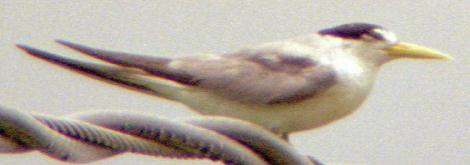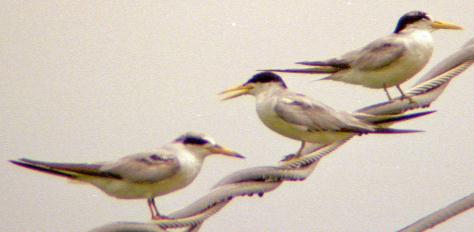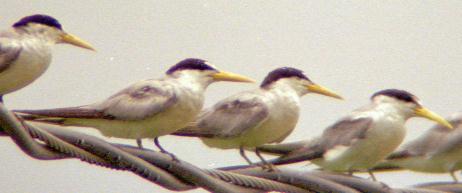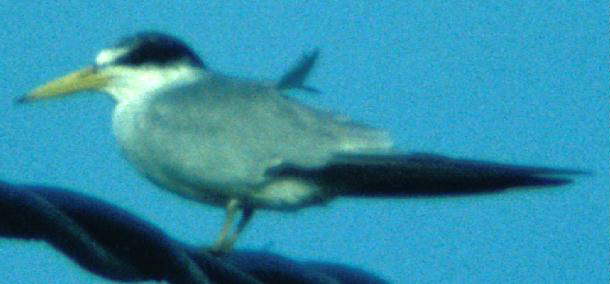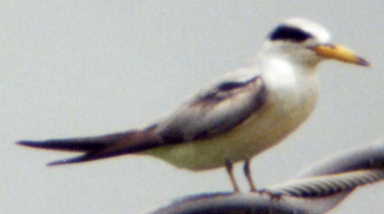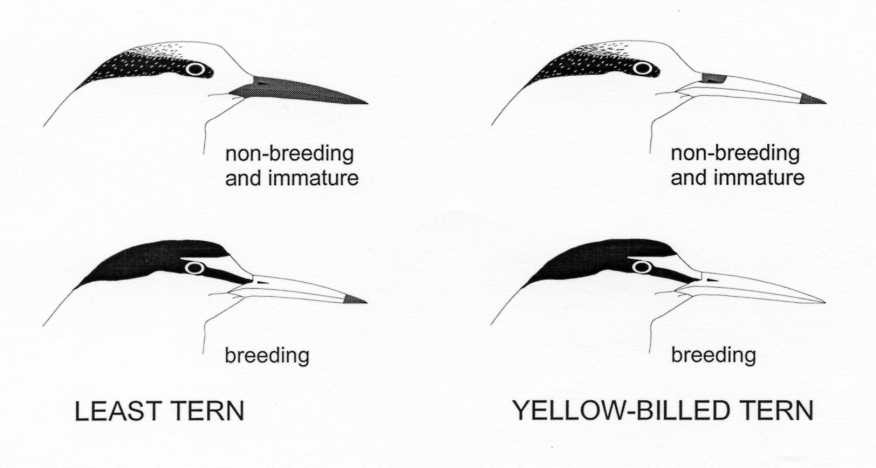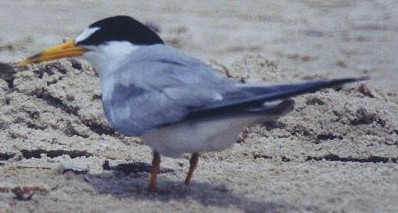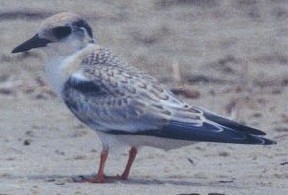The Yellow-billed Tern nests primarily along large
rivers in South America and frequently wanders to the coast, especially
during the non-breeding season. It closely resembles the Least Tern,
which breeds along coasts and larger rivers of South America and on
many Caribbean islands, including those off northern South America, and
winters along the coasts of South America. The differences between
these two species were discussed by Hayes (2001) and are summarized in
this photo essay.
Immature plumage.--Immatures
of both species are readily distinguished from adults by the presence
of a dark carpal bar on the lesser wing coverts, which is markedly
darker in the Least Tern and typically faint in the Yellow-billed Tern.
The crown is white, often with dark flecking, and a thick, dark stripe
extends from the eyes across the nape (Fig. 1).
Basic (non-breeding) plumage.--Individuals
in this plumage resemble immatures but lack the dark carpal bar. The
outer primaries become worn and more extensively dark than in alternate
(breeding) plumage. There appear to be be no consistent differences in
plumage between the two species at this stage.
Alternate (breeding) plumage.--Individuals
in this plumage possess a dark crown and nape with a V-shaped, white
forehead patch extending just behind the eye in the form of a narrow
supercilium (Fig. 1). In freshly moulted individuals the supercilium is
slightly narrower in the Yellow-billed Tern, though given the
variability in the stage of moult this feature is seldom useful for
identification. Although not mentioned in the article by Hayes (2001),
the black "arrow" between the bill and eye appears to connect lower on
the bill and extend lower on the face in Least Tern. In Least Tern, the
outermost two (rarely three) primaries are dark compared with three
(rarely two to four) in Yellow-billed Tern (contra
several references which state that the outermost four primaries in
Yellow-billed Tern). Thus, the Yellow-billed has a more extensive black
wedge on the wingtip.
Body size and shape.--The
Yellow-billed Tern is slightly larger than Least Tern, with a 9%
difference in mean wing length and only slight overlap. In freshly
moulted individuals the tail is proportionately longer and more forked
in Least Tern, but because of variation in moult and wear this feature
is seldom useful for identification.
Bill size.--Yellow-billed
Tern has a proportionately heavier bill that averages 8% longer than
that of Least Tern (Fig. 1). This feature is readily apparent in most
individuals, but slight overlap occurs between long-billed male Least
Terns and short-billed female Yellow-billed Terns.
Bill colouration.--In
alternate plumage, Yellow-billed Tern has an entirely yellow bill; the
Least Tern usually has a dark tip to the bill (Fig. 1), but in some
individuals it is entirely yellow. The differences between the two
species are most pronounced in basic plumage, when Least Tern has a
dark bill and Yellow-billed Tern has a mostly yellow bill with a dusky
tip and a dusky patch around the nostrils (contra several references which state the bill is entirely yellow. These differences are illustrated below.
Leg colouration.--Although
not mentioned in the article by Hayes (2001), the legs of Yellow-billed
Tern may be more consistently yellowish in all plumages than in Least
Tern, in which they are usually more orangeish or darker.
LITERATURE CITED
Hayes, F. E. 2001. Identification of Least Tern Sterna antillarum and Yellow-billed Tern S. superciliaris, with a
sight record of Yellow-billed Tern from Tobago, West Indies. Cotinga 15:10-13.
PHOTO INDEX
Perched (page 1)
Flight (page 2) |
